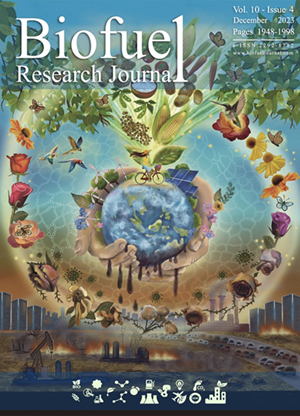Green diesel production through simultaneous deoxygenation of palmitic acid and desulfurization of 4,6-Dimethyl-dibenzothiophene over commercial CoMo/Al2O3
IF 11.9
Q1 ENERGY & FUELS
引用次数: 3
Abstract
This study investigated the deoxygenation of palmitic acid as a model compound of palm fatty acid distillate (PFAD), in the presence of 4,6- di-methyl-di-benzothiophene as a sulfur-containing light gas oil (LGO). Reactions were performed at the pressure of 25 barg, liquid hourly space velocity (LHSV) of 1.7 h-1, and H2/oil of 630 NL/L over CoMo/Al2O3 as catalyst. The effect of temperature was studied in the range of 275-300 oC. Both deoxygenation and desulfurization led to approximately 100% conversions at 300 oC, while at 275 oC, palmitic acid deoxygenation was recorded at a higher conversion rate compared with that of the desulfurization of 4,6- di-methyl-di-benzothiophene. The presence of 4,6- di-methyl-di-benzothiophene during the deoxygenation of palmitic acid resulted in high conversions (>95%). Pressure drop studies showed that the formation of heavy products caused a gradual pressure drop throughout the reactor over time. The catalyst was deactivated during 10 d. Two different sulfur-containing reagents were used for catalyst reactivation including dimethyl-disulfide in n-C18 and LGO containing 484 ppmw of sulfur. Reactivation with 2 wt.% of dimethyl-disulfide in n-C18 at 320 oC for 36 h led to more favrable performance recovery vs. the sulfur-containing LGO.在商用CoMo/Al2O3上同时进行棕榈酸脱氧和4,6-二甲基二苯并噻吩脱硫生产绿色柴油
本研究研究了棕榈酸作为棕榈脂肪酸馏出物(PFAD)的模型化合物,在含硫轻质瓦斯油(LGO)4,6-二甲基二苯并噻吩存在下的脱氧反应。在CoMo/Al2O3作为催化剂上,在25barg的压力、1.7h-1的液体时空速(LHSV)和630NL/L的H2/油下进行反应。在275-300℃的温度范围内研究了温度的影响。脱氧和脱硫在300℃时都导致约100%的转化率,而在275℃时,与4,6-二甲基二苯并噻吩的脱硫相比,棕榈酸脱氧的转化率更高。棕榈酸脱氧过程中4,6-二甲基二苯并噻吩的存在导致高转化率(>95%)。压降研究表明,随着时间的推移,重产物的形成导致整个反应器的压力逐渐下降。催化剂在10d期间失活。使用两种不同的含硫试剂进行催化剂再活化,包括n-C18中的二甲基二硫化物和含有484ppmw硫的LGO。与含硫LGO相比,在n-C18中用2 wt.%二甲基二硫在320℃下反应36小时可获得更有利的性能回收率。
本文章由计算机程序翻译,如有差异,请以英文原文为准。
求助全文
约1分钟内获得全文
求助全文
来源期刊

Biofuel Research Journal-BRJ
ENERGY & FUELS-
CiteScore
22.10
自引率
1.50%
发文量
15
审稿时长
8 weeks
期刊介绍:
Biofuel Research Journal (BRJ) is a leading, peer-reviewed academic journal that focuses on high-quality research in the field of biofuels, bioproducts, and biomass-derived materials and technologies. The journal's primary goal is to contribute to the advancement of knowledge and understanding in the areas of sustainable energy solutions, environmental protection, and the circular economy. BRJ accepts various types of articles, including original research papers, review papers, case studies, short communications, and hypotheses. The specific areas covered by the journal include Biofuels and Bioproducts, Biomass Valorization, Biomass-Derived Materials for Energy and Storage Systems, Techno-Economic and Environmental Assessments, Climate Change and Sustainability, and Biofuels and Bioproducts in Circular Economy, among others. BRJ actively encourages interdisciplinary collaborations among researchers, engineers, scientists, policymakers, and industry experts to facilitate the adoption of sustainable energy solutions and promote a greener future. The journal maintains rigorous standards of peer review and editorial integrity to ensure that only impactful and high-quality research is published. Currently, BRJ is indexed by several prominent databases such as Web of Science, CAS Databases, Directory of Open Access Journals, Scimago Journal Rank, Scopus, Google Scholar, Elektronische Zeitschriftenbibliothek EZB, et al.
 求助内容:
求助内容: 应助结果提醒方式:
应助结果提醒方式:


